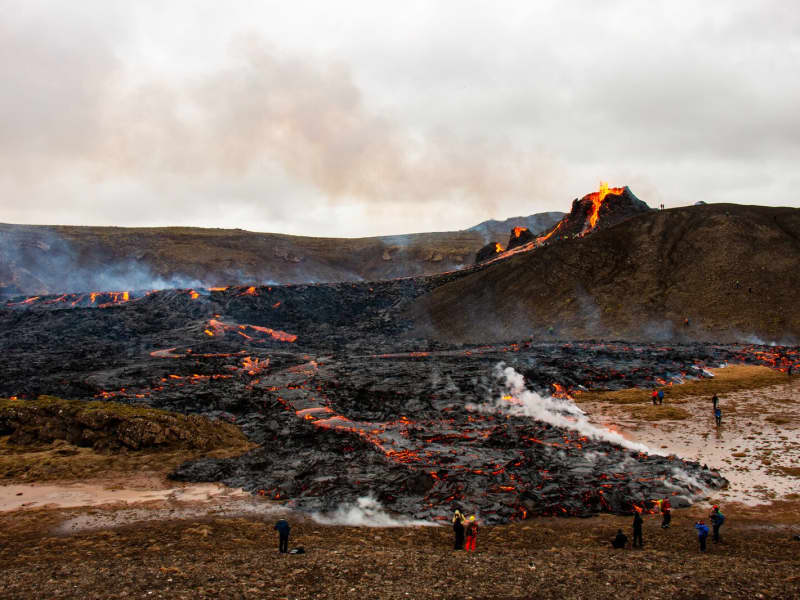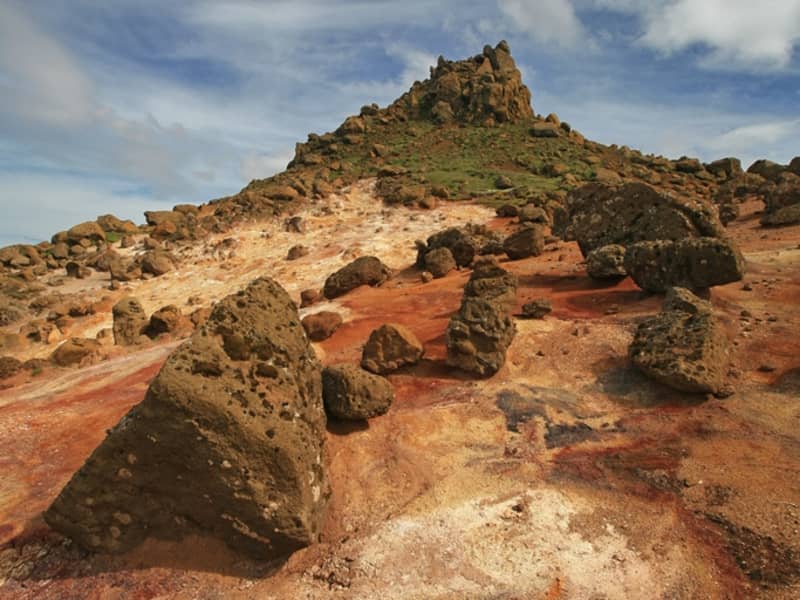
Krýsuvík
Popular recreational destination with many interesing hiking paths.
Columns of steam rise skywards, bubbling mud pools play their rhythmical symphony, and the banks around the hot springs are coloured green, yellow and red. The Grænavatn and Gestastaðavatn lakes and the two small pools on each side of the road further south, Augun (Eyes), are all explosion craters created by volcanic eruptions at various times. Grænavatn lake is the largest, some 46 metres deep, with green water due to thermal algae and crystals which absorb the sun. The main geothermal areas in Krýsuvík are Seltún, Hverahvammur, Hverahlíð, Austurengjar, the southern part of Kleifarvatn and Sveifla beneath Hettutindur. The Fúlipollur mud spring is east of the main road.Lake Kleifarvatn is the largest lake on the Reykjanes peninsula, and the third-largest lake of southern Iceland, 9.1 km². It is also one of the country's deepest lakes, at 97 metres. It varies in size over the year. Since 2000 it has been shrinking, after two major earthquakes probably opened up fissures on the lake bottom. Trout fry were released into the lake in the 1960s, and the fish have thrived quite well. According to legends a monster in the shape of a serpent, as big as a medium-sized whale, lurks in the lake. Krýsuvík was once a separate parish, with one of the largest estate farms in the country, and many tenants crofts. The church, built in 1857, was restored in 1964 and is part of the National Museum's Historic Buildings Collection. On the hill and around it, traces of the old farmhouse and other buildings can still be seen, although they are somewhat overgrown with grass. It should be kept in mind that the area's magnificent nature is very delicate and must be treated with great care and respect.
Location: By road 42. 1km west of Grænavatn which is 3km south-west of Kleifarvatn
View
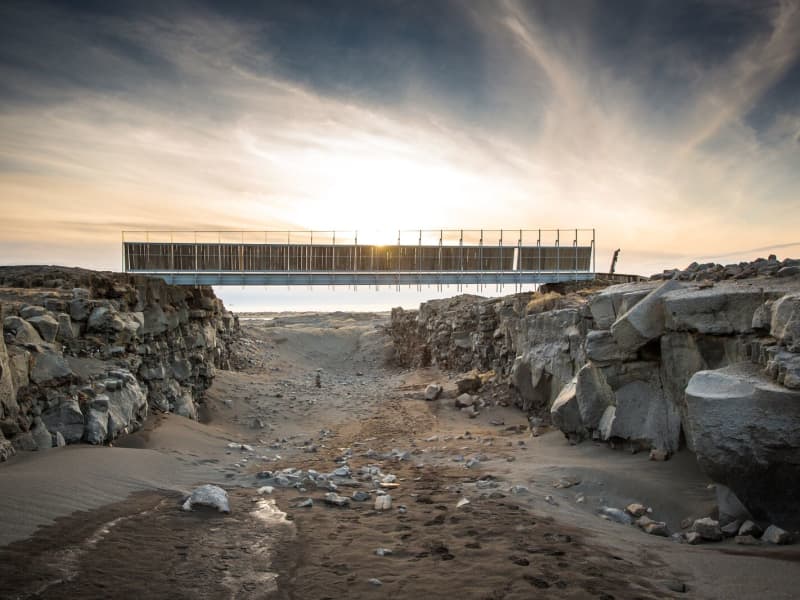
Bridge Between Continents
Note: An increase in seismic activity has been on the Reykjanes Peninsula over the last weeks. As a result, new cracks have formed—or existing ones have reopened—in several locations, including near popular sites such as the Bridge Between Continents.
These cracks can be hard to spot and may pose a danger, especially near cliffs or unmarked areas. We strongly encourage all visitors to stay on marked trails and paths and to avoid getting too close to any visible cracks or edges.
A symbolic bridge between Europe and North America on the Reykjanes Peninsula.
The lava-scarred Reykjanes peninsula lies on one of the world's major plate boundaries, the Mid-Atlantic Ridge. According to the continental drift theory, the Eurasian and North American tectonic plates are continuously drifting apart with great forces under the gaping rifts. As the plates diverge, linear fractures, known as fissures, form due to stresses created by the tension that builds up as the plates move away from each other.
The Bridge between two continents at Sandvík is a small footbridge over a major fissure, which provides clear evidence of the presence of a diverging plate margin. The bridge was built in 2002 as a symbol for the connection between Europe and North America.
One can cross the continental divide on Leif the Lucky's Bridge and take home a personalised certificate at the information center in the Folk museum in Gardur and the Reykjanes Geopark visitor center at Duus Cultural house.
View
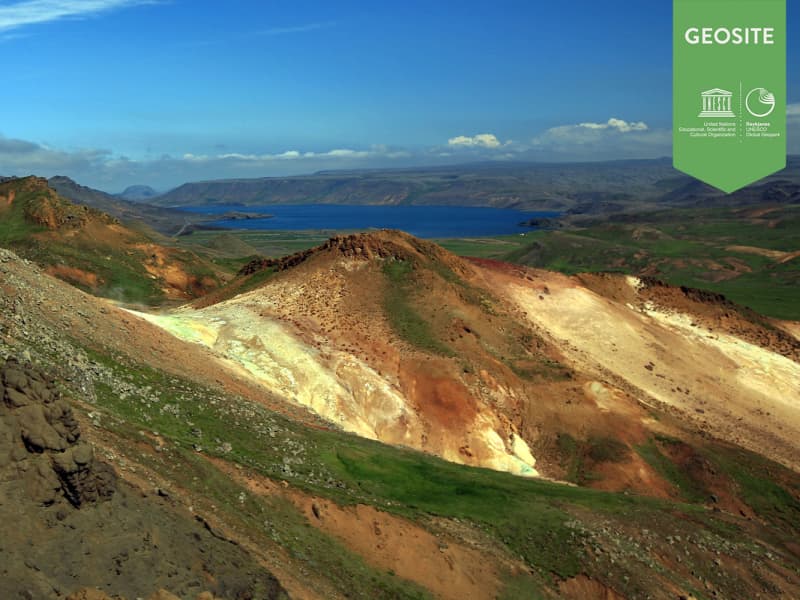
Sveifluhals
A lava flow formed in an eruption in the year 1151 AD.
In that year a 25 km long fissure opened obliquely across the Reykjanes peninsula. The lava field is located in south of ridge Nupshlidarhals(Vesturhals) and craters in the northern part are part of crater row in the north of Ridge Nupshlidarhals. Ogmundur is a male name in Iceland.
Located West of Lake Kleifarvatn. Drive road 427 and turn left on road 42 then park at Seltún and walk Preststígur. Walk estimated 2-3 hours up and down.
View
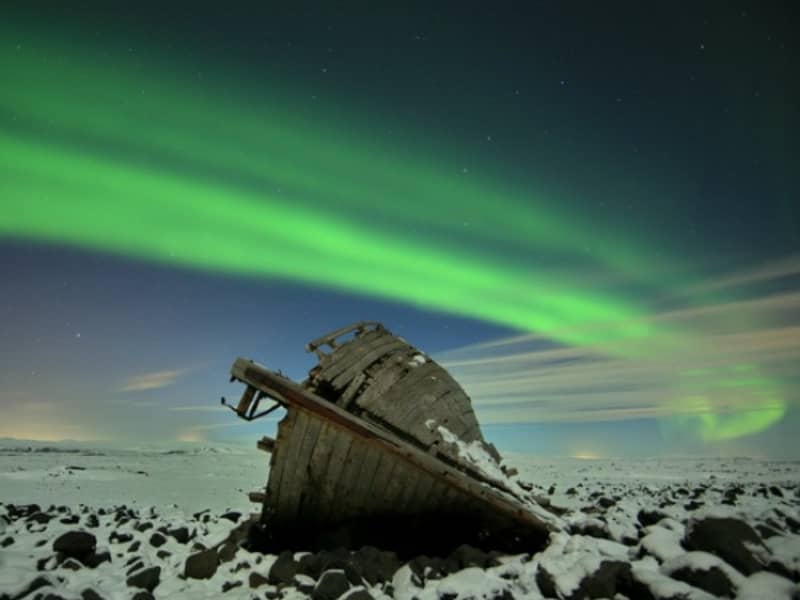
Northern lights - Aurora Borealis
Auroras are associated with the solar wind, a flow of ions continuously flowing outward from the sun. The Earth´s magnetic field traps these particles, many of which travel toward the poles where they are accelerated toward Earth. Collisions between these ions and atmospheric atoms and molecules causes energy releases in the form of auroras appearing in large circles around the poles. Auroras are more frequent and brighter during the intense phase of the solar cycle when coronal mass ejections increase the intensity of the solar wind. Seen from space, these fiery curtains form a thin ring in the shape of a monk´s tonsure.The Northern Lights occur high above the surface of the earth where the atmosphere has become extremely thin, in an altitude of 100-250km
In the past theories have been proposed to explain the phenomenon. These theories are now obsolete. Benjamin Franklin theorized that the mystery of the Northern Lights was caused by a concentration of electrical charges in the polar regions intensified by the snow and other moisture.
The first Old Norse account of norðrljós is found in the Norwegian chronicle Konungs Skuggsjá from AD 1230. The chronicler has heard about this phenomenon from compatriots returning from Greenland and he gives tree possible explanations: that the ocean was surrounded by vast fires, that the sun flares could reach around the world to its night side, or the glaciers could store energy so that they eventually became fluorescent.
Usually from late September until the beginning of April, the Northern Lights can be seen in Iceland in most places. In dark areas away from city lights these are best seen. Important one chooses the right evening with clear skies.
View
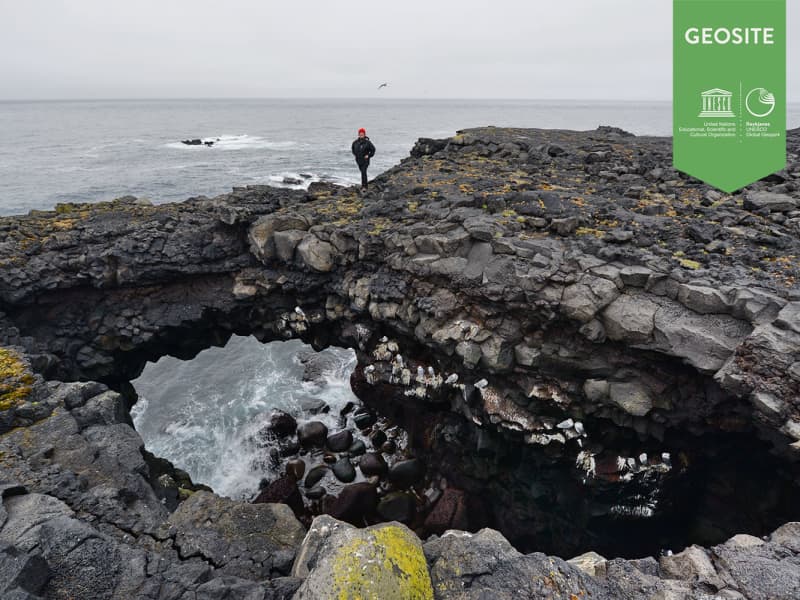
Hafnaberg - Sea-cliffs
Hafnaberg is a long line of sheer sea lava cliffs south of the old fishing hamlet of Hafnir.
Hafnaberg is very popular among hikers and bird watchers as various marine birds nest at the cliffs. A parkingplace is located 4 km from Hafnir on road 44 and from there is a marked path from the road to the cliffs.
Hafnaberg is a geosite in Reykjanes Unesco Global Geopark.
View
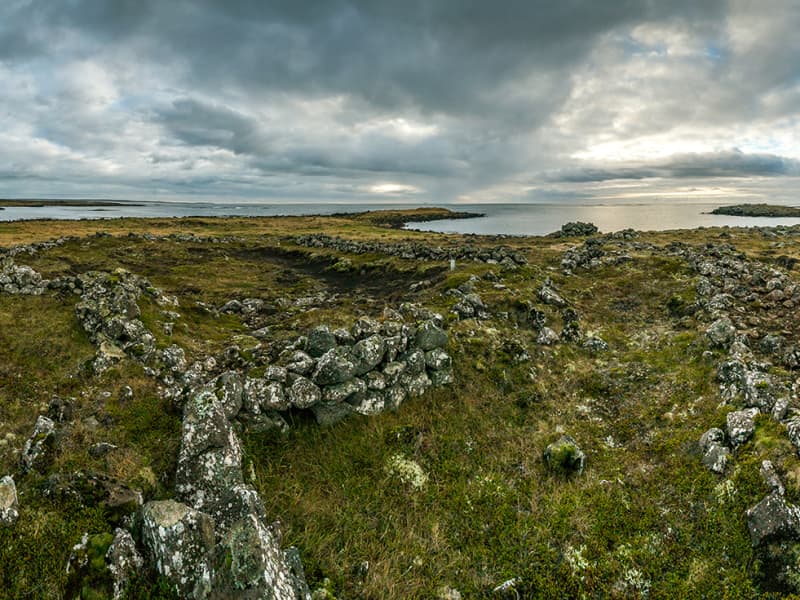
Basendar
An ancient fishing outfit and a trading post just south of Stafnes.
It was one of the harbours of the Danish Trade Monopoly posts comprising Hafnir, Stafnes and Midnes. During the night of January 9th 1799 a catastrophic tidal flood devastated Batsendar. It swept most of the houses away and some of the people barely escaped. Only one old woman drowned. This was the most devastating, tidal flood in the history of the country.
How to get there: Road from Sandgerði to Stafnesi. There is a parking and walk from there until you see ruins of the place and old wall made from rocks.
View
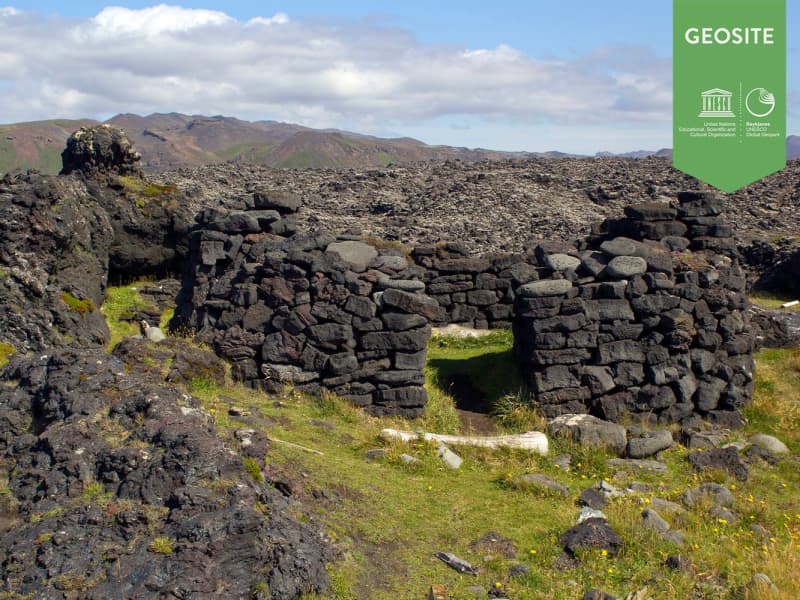
Selatangar
Selatangar was a big fishing outfit between Grindavik and Krysuvik.
It was abolished after 1880. Extended ruins of the abodes and other houses are still very prominent in the landscape. They have been declared inviolate. During the latter part of the 19th century ghosts started haunting the settlement. Driftwood was in abundance at Selatangar in the past, but less nowadays. The surroundings are grandious, low mountains and lava fields.
How to get there: A track for 4wd-vehicles lies down to the ruins on the coast from the road to Isolfsskali.
View
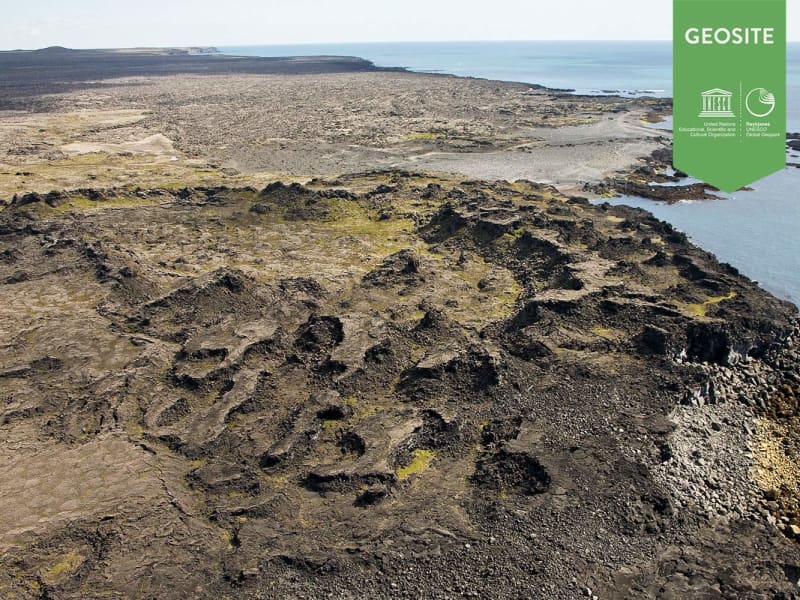
Katlahraun
Katlahraun is lava that flowed about 2,000 years ago and entered the sea. Sudden damming at the shore caused a large, circular lava pond to form. Some lava solidified, but the remaining liquid escaped. The site now contains beautiful and various lava formations.
Katlahraun is a geosite within Reykjanes Uneco Global Geopark.
View
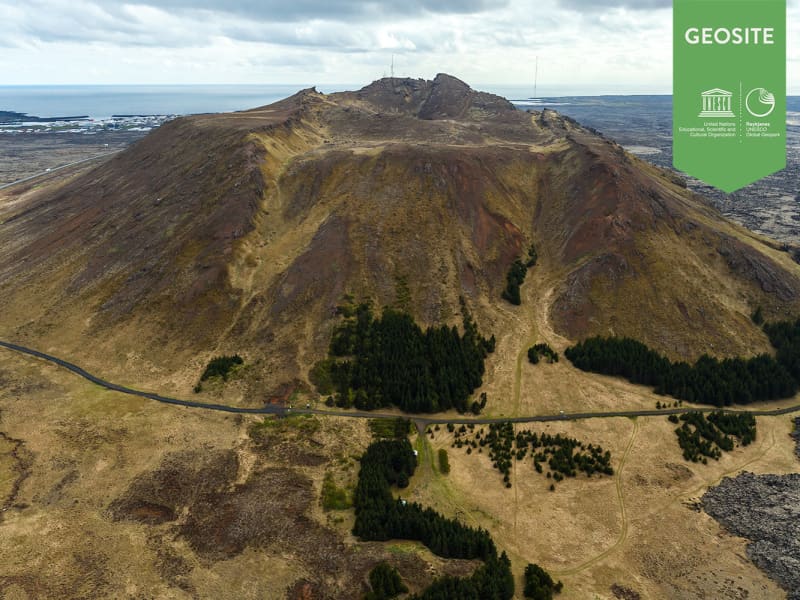
Mt Thorbjorn
A free standing, hyaloclastite mountain north of Grindavik.
It offers great panoramic view over most of the Reykjanes Peninsula on fine days. The northeastern part of the mountain depicts thermal activity an to its north and northeast is an extensive high temperature area. It is split by a fissure called "The Thieves´ Gap" (Thjofagja), occupied by 15 thieves according to the legend. They were eventually overwhelmed and killed by trickery.
View

